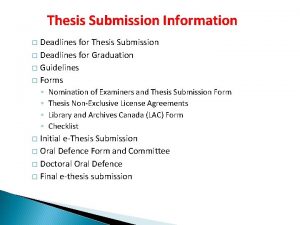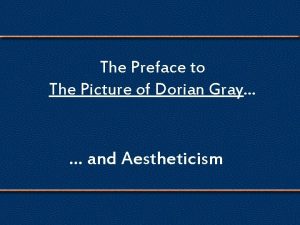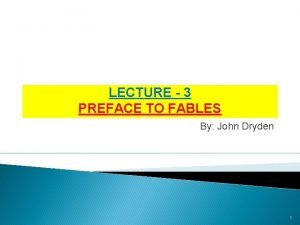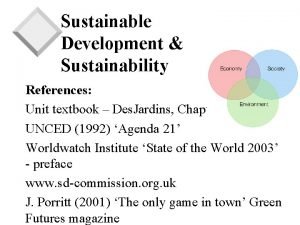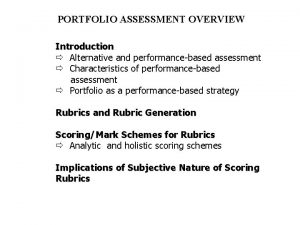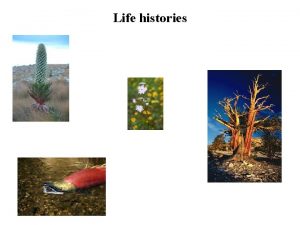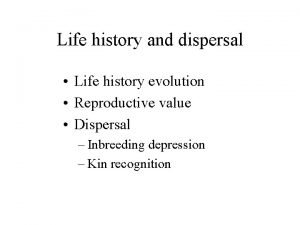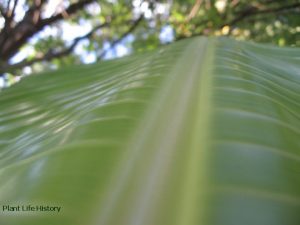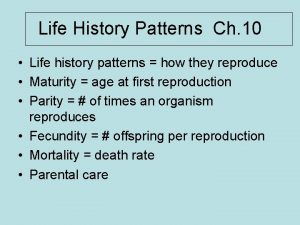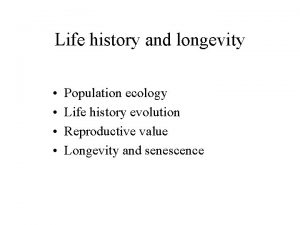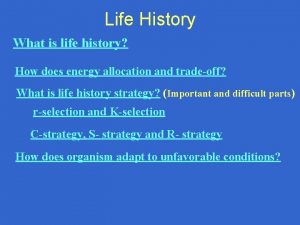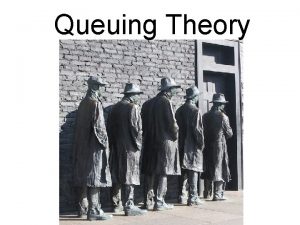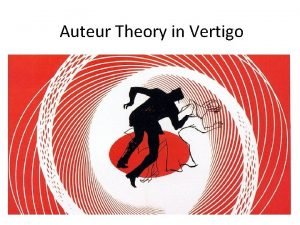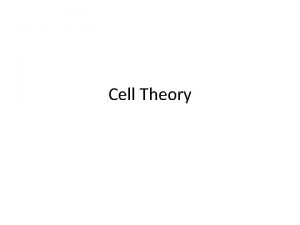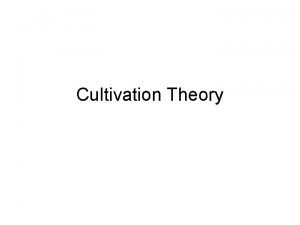THE HISTORY OF LIFE A PREFACE TO THEORY
























- Slides: 24

THE HISTORY OF LIFE: A PREFACE TO THEORY OF EVOLUTION

EARLY HISTORY OF EARTH • Earth is 4. 6 billion years old WHAT WAS IT LIKE? • Inhospitable • Very hot • Anaerobic Ancient atmosphere consisted of: 1. water vapor 2. carbon dioxide 3. nitrogen

EARLY HISTORY OF EARTH • By 3. 9 billion years ago, Earth might have cooled enough for water in the atmosphere to condense • Millions of years of rainstorms filled the oceans • It is in the oceans, 3. 9 -3. 5 billion years ago, ago that scientists propose the first living organisms appeared

EARLY HISTORY OF EARTH • How do we know what the some of these organisms looked like? • Fossil evidence! • FOSSIL = evidence of an organism that lived long ago • Organism buried in small particles of soil soon after dying • Soil particles are compressed over time = sedimentary rock

Why aren’t soft parts of bodies preserved in fossils?

TYPES OF FOSSILS TRACE FOSSIL = marking left by an animal (footprint, trail, burrow, etc. ) CAST = when minerals in rocks fill a space left by a decayed organism… makes a cast (replica) of the organism PETRIFIED FOSSIL = when minerals penetrate and replace the hard parts of an organism (makes copy)

TYPES OF FOSSILS IMPRINTS = thin object (leaf) falls into sediment and leaves imprint when sediment hardens AMBER-PRESERVED = organism quickly trapped in tree sap (also frozen in ice) MOLD = forms when an organism is buried in sediment and decays, leaving an empty space

TYPES OF FOSSILS Trace (T. Rex) Mold Cast Petrified Wood Amber Imprint

THE AGE OF A FOSSIL 1. RADIOMETRIC DATING • determines specific ages of fossils • Radioactive isotopes decay at a measurable rate • As they decay, they turn in to something new • Half-life = time it takes for half of the radioactive isotope to decay and turn in to something new

THE AGE OF A FOSSIL RADIOMETRIC DATING RADIOACTIVE ISOTOPE HALF-LIFE Potassium-40 1. 3 billion years Carbon-14 5730 years

THE AGE OF A FOSSIL • A scientist was dating a fossil using carbon-14. If he began with 20 grams, and all that remained were 5 grams, how old is the fossil (hint: the half life of C 14 = 5730 years)

THE AGE OF A FOSSIL 2. RELATIVE DATING • Fossils are found in different layers of rock • Top layers younger • Bottom layers older • Cannot determine the actual age!

Review…. • How old do scientists believe the Earth is? • What was our Earth originally like? • What gases were present in early Earth’s atmosphere? • Where on Earth do scientists propose life first began? • How do fossils form? • What are the six types of fossils? • What are the two ways we can date/determine the age of a fossil? Which is more accurate?

How did life appear? • Used to believe in spontaneous generationliving things came from nonliving things

How did life appear? • In the 1950 s, American scientists Miller and Urey conducted experiments to determine if organic molecules could have been created from the harsh environment of early earth • Simulated early atmosphere conditions by filling a flask with hydrogen, methane, ammonia, and water to represent the atmosphere • Passed electric sparks through the mixture to simulate lightning

How did life appear? • Amazing results! Over a few days several amino acids began to accumulate! • Recall: What are amino acids?

Evolution of Living Organisms A. First Cells = PROKARYOTES!!! - Bacteria - Anaerobic because Earth’s early atmosphere lacked Oxygen - Food = small molecules in the early ocean - If they had to obtain their food, where they heterotrophs or autotrophs? ? ?

Evolution of Living Organisms -Over time fossil evidence shows organisms evolved to survive in the presence of oxygen…. but where did oxygen originate from? -Photosynthetic Prokaryotes! -make their own food - product of photosynthesis = oxygen * formation of the ozone layer * life comes from the sun

Evolution of Living Organisms • The rise of oxygen in the atmosphere led to the extinction of some life forms, while other life forms evolved new, more efficient metabolic pathways that used oxygen for RESPIRATION • How did eukaryotes develop over time? • Endosymbiotic theory

Evolution of Living Organisms • Endosymbiotic theory proposes that eukaryotic cells arose from living communities formed by prokaryotic organisms.

Evidence for Endosymbiotic Theory • 1. Mitochondria and choloroplasts contain DNA similar to bacterial DNA • 2. Mitochondria and bacteria have ribosomes whose size and structure closely resembles bacteria • 3. Mitochondria and bacteria reproduce the same way – binary fission • http: //educationportal. com/academy/lesson/theendosymbiosis-theory-evolution-ofcells. html

Evolution of Living Organisms • Most prokaryotes reproduce asexually • What process do they reproduce by? • Some time after eukaryotes developed, cells began to reproduce sexually • Remember sexual reproduction (meiosis) results in greater genetic diversity and variation • Increasing the number of gene combinations increases the probability that favorable combinations will be produced – favorable combinations greatly increase the chance of evolutionary change in a species

EARLY HISTORY OF EARTH • Are scientists sure that life began this way? NO • There is no direct evidence of these early years • The oldest rocks that have been found on Earth are only 3. 9 billion years old

Review • • What is spontaneous generation? What did Miller and Urey’s experiment prove? What did the first organisms look like? From there they were able to make their own food, so they evolved into __________. • Then the organisms developed into ______ that started to reproduce ______. • What theory explains how eukaryotes evolved over time? • Finally, ________ organisms appeared.
 Invitation letter for thesis defense
Invitation letter for thesis defense Preface to dorian gray
Preface to dorian gray Miss julie naturalism
Miss julie naturalism John dryden preface to the fables
John dryden preface to the fables Introduction of harry potter
Introduction of harry potter Preface of a book example
Preface of a book example Preface from behind the scenes
Preface from behind the scenes Preface
Preface Sustainability pillars
Sustainability pillars Portfolio introduction
Portfolio introduction Hát kết hợp bộ gõ cơ thể
Hát kết hợp bộ gõ cơ thể Bổ thể
Bổ thể Tỉ lệ cơ thể trẻ em
Tỉ lệ cơ thể trẻ em Gấu đi như thế nào
Gấu đi như thế nào Chụp phim tư thế worms-breton
Chụp phim tư thế worms-breton Chúa sống lại
Chúa sống lại Môn thể thao bắt đầu bằng chữ đua
Môn thể thao bắt đầu bằng chữ đua Thế nào là hệ số cao nhất
Thế nào là hệ số cao nhất Các châu lục và đại dương trên thế giới
Các châu lục và đại dương trên thế giới Công của trọng lực
Công của trọng lực Trời xanh đây là của chúng ta thể thơ
Trời xanh đây là của chúng ta thể thơ Mật thư anh em như thể tay chân
Mật thư anh em như thể tay chân Phép trừ bù
Phép trừ bù độ dài liên kết
độ dài liên kết
